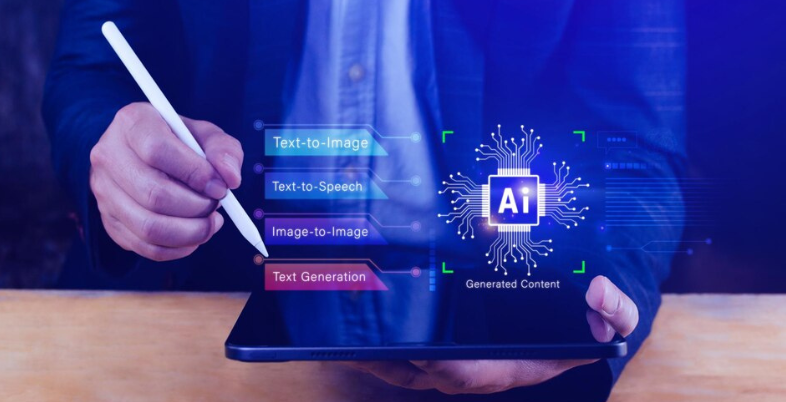Generative AI is changing how software is developed by automating tasks, improving code creation, and speeding up testing. It offers developers powerful tools to innovate faster and more efficiently. Yet, alongside these advancements, developers face significant ethical responsibilities. In the responsibility of using generative AI, they must ensure AI systems are fair, transparent, and respect user privacy.
Here, we’ll explore the key benefits of using generative AI in content creation, examining how it empowers creators, increases productivity and fosters innovation. Whether you’re an experienced content creator or just starting out, understanding the power of AI enablement can open up new possibilities and lead you in the direction of successfully in an ever-evolving digital world.
What is AI Generative?

AI Generative refers to artificial intelligence systems that can create new objects such as text, images, music, or virtual environments based on input data and learned patterns These systems use generative models that learn from large datasets to understand design and its distribute the footnotes.
Generative AI has applications in a variety of industries: chatbots, text generation for content creation and language translation, with models such as OpenAI’s GPT-3 and GPT-4; image generation for art, design, and virtual photography, using models such as DALL-E and GANs (Generative Adversarial Networks); music and audio generation for composition and realistic audio effects in the music and entertainment industries; video generation with animations and deepfake; and create immersive virtual worlds for games, simulations, and virtual reality applications. Generative AI uses neural networks and other techniques, especially deep learning models, to extract these tasks from the massive data of trained early innovators.
How does AI help in Content Creation?
AI product developers work by using advanced computer programs called models that learn patterns from large amounts of data. These models, usually neural, are trained when exposed to large data sets—such as books, text, pictures, or sounds. During training, the AI learns to understand the patterns and relationships in this data. For example, a text generator AI like GPT-4 reads and learns millions of sentences to understand syntax, context, and common sentences.
When an AI is asked to do things, it uses what the AI has learned to create new information. Given a few prompts or words, the AI predicts the next sections of content and based on its training. This process involves identifying patterns and making learned assumptions to obtain consistent and relevant information.
For example, if you ask an AI to write an essay, it will use its knowledge of narrative, human development, and language in much the same way that an AI uses familiar elements such as reasoning, color, and the method of synthesis in order to obtain a new image. Essentially, AI content creators mimic human creativity by learning from existing data and using that knowledge to create something new and original.
How is content creation with AI done?
Machine learning is used in AI content development to improve and expedite the content generation process. This is an explanation of how it functions:
- Understanding and Natural Language Processing (NLP): AI is fundamentally based on the analysis of vast amounts of preexisting text data using NLP techniques. Websites, articles, books, and social media information can all be included in this data. The AI learns the grammatical structures and patterns of human language by analyzing this data.
- Content Generation: The AI is capable of producing original content once it has a grasp of linguistic patterns. This may entail writing content in many formats, such as product descriptions, blog entries, or captions for social media posts. Usually, users give explicit instructions or hints to steer the AI in the desired path.
- Optimization and Personalization:AI can also be used to target consumers with content or optimize it for search engines. The AI can determine what resonates and adjust the content by examining user data and engagement metrics.
Benefits of Using Generative AI in Content Creation

Generative AI, the branch of artificial intelligence that generates new products by learning from existing data, has become a revolutionary force in various industries with applications ranging from information processing and visualization to songwriting and video production. Among its many benefits are the key benefits of using generative AI in content creation and the ability to dramatically increase productivity and creativity This blog will delve into how generative AI does this, examining its impact on productivity, quality, and innovation in content creation.
Enhancing Efficiency in Content Creation
One of the most compelling benefits of generative AI is its ability to do things fast and scalable. Traditional manufacturing methods generally require more time and human effort. For example, writing, drawing, or composing music can take hours, days, or even weeks. However, Generative AI can produce high-quality results in a fraction of the time. This advancement allows creators and entrepreneurs to accomplish more in less time, meeting the growing demand for new and exciting content.
- Automation of Repetitive Tasks
Generative AI excels at automating mundane tasks that are often automated, freeing up human designers to focus on the more complex strategic aspects of content creation e.g., AI can automate the generation of product descriptions for an e-commerce website types, write original articles, or make marketing copy changes and materials You can focus on refining and perfecting yourself.
Boosting Creativity and Innovation
- Expanding Creative Boundaries
Generative AI can push the boundaries of creativity by introducing new concepts and ideas that human designers haven’t thought of. By learning from different types of data, AI can create combinations in unique ways, leading to innovative and original creations. For example, AI can create artworks that blend artwork or compose songs that blend different genres. This ability to be unconventional and imaginative can inspire human artists and lead to success in creative endeavors.
- Collaboration Between Humans and AI
Generative AI is a powerful tool that brings humans and machines together. AI can replace human artists as creative partners, offering suggestions, creating notes, and enhancing the creative process. For example, writers can use AI-generated text as a starting point or overcome writer’s block, while designers can use AI-generated images as inspiration for their work This form of collaboration allows human designers to harness the power of AI and infuse their creativity and expertise into the final output.
Improving Content Quality and Consistency
Generative AI can analyze large amounts of data to identify patterns and trends that inform production. This data-driven approach ensures content is relevant, engaging, and in line with audience preferences. For example, AI can analyze user behavior and feedback to tailor content to specific target audiences. By leveraging this insight, companies can create more effective and personalized content that drives engagement and conversion.
- Consistency in Brand Messaging
Creating a strong brand is essential to maintaining a consistent brand message across a variety of contexts and channels. Generative AI can help ensure this convergence is accurate by generating content that aligns with pre-defined brand direction and voices. For example, AI can create social media posts, blog posts, and email newsletters that consistently reflect the brand’s voice and values. This consistency increases brand recognition and builds trust with the audience.
Cost-effectiveness and Resource Optimization
- Reducing Content Production Costs
Traditional events can be resource-intensive, requiring skilled labor, considerable time, and investment. Generative AI offers a cost-effective alternative by automating many stages of production. While the initial investment is in developing and training AI models, the long-term savings can be substantial. Companies can reduce labor costs and allocate resources more efficiently, allowing them to produce higher-quality products within budget constraints.
- Scalability Without Proportional Costs
Generative AI enables businesses to scale their content creation efforts without incurring significant costs. As demand increases, AI is able to handle the increased workload without the need for additional human resources. This scalability is especially valuable for businesses with fluctuating resource demands, such as seasonal marketing campaigns or product launches. By leveraging AI, companies can meet these demands faster and more cost-effectively.
Ethical and Practical Considerations
- Addressing Bias and Ethical Concerns
While AI-enabled reproduction brings many benefits, it is important to address ethical considerations and potential biases in the results of AI. AI models can unintentionally learn and simulate biases in their training data, resulting in biased or inappropriate results. To mitigate this risk, it is important to use representative data sets, implement rigorous testing, and continuously monitor and refine AI models. Ensuring that AI-powered content is transparent and accountable is critical to maintaining ethical standards and building trust with audiences.
- The Role of Human Oversight
Despite AI-enabled capabilities, human oversight is still important in the manufacturing process. Human designers play a key role in analyzing, cleaning, and editing AI-generated content to ensure accuracy, relevance, and quality. This oversight is especially important in sensitive or high-profile cases, such as news or medical cases. By combining high-performance AI with human judgment and knowledge, companies can have the best of both worlds.
Real-World Applications and Success Stories
Generative AI has made great strides in the media and publishing industries. News organizations are using AI to create news stories, summaries, and reports, allowing journalists to focus on in-depth investigative work. For example, The Washington Post’s AI tool Heliograph has successfully created news coverage for sports and elections. This use of AI has enabled the publication to provide readers with timely and accurate information.
- Marketing and Advertising
In marketing and advertising, generative AI is changing the way campaigns are designed and executed. AI can create personalized marketing content, such as email campaigns, social media posts, and ads, tailored to individual consumer preferences. This personalization increases customer engagement and increases conversion rates. Additionally, AI-generated content can be A/B tested to determine the most effective messaging, further optimizing marketing efforts.
Entertainment and Creative Arts
Entertainment and the creative arts are also using generative AI to push creative boundaries. The creation of music, art, and even movie scripts using AI is becoming increasingly common. For example, AI composer Aiva has created hits with human orchestras, while artists like Mario Klingemann are using AI to create unique and thought-provoking works of art These applications demonstrate how AI can enable human creativity and could lead to new art sermons.
E-commerce and Retail
Generative AI in e-commerce and retail enhances customer experience through personalized product descriptions, recommendations, and reviews. AI-enabled products can be personalized to individual shoppers, making the shopping experience more engaging and relevant. For example, online retailer ASOS uses AI to create product descriptions that match the brand’s tone and style, creating a more consistent and enjoyable shopping experience for customers.
Conclusion
Generative AI is revolutionizing content creation by enhancing efficiency, boosting creativity, improving quality, and optimizing resources. Its ability to produce high-quality content rapidly and at scale, combined with its capacity to introduce novel ideas and insights, makes it an invaluable tool for businesses and creators. While ethical considerations and the need for human oversight remain important, the benefits of generative AI in content creation are undeniable. As AI technology continues to advance, its role in shaping the future of content creation will only grow, offering exciting possibilities for innovation and transformation across industries.

















